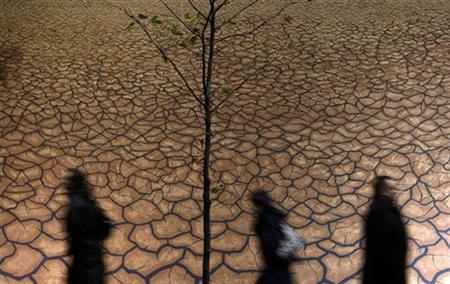Photographs: Carlos Barria/Reuters
Now that the India Meteorological Department (IMD) has endorsed the fears expressed earlier by foreign weather bureaux about the emergence of the monsoon-unfriendly El Nino in the second half of the season, the government should begin preparing right away for mitigating its adverse impacts on agriculture, water reservoirs and other areas.
El Nino, an anomalous rise in sea surface temperature off the Peru coast, has been observed to often cause the Indian monsoon to flounder, resulting in poor rainfall. Nearly 60 per cent of agricultural land is wholly rain-dependent.
Most pulses and oilseeds, which are already scarce and are contributing to double-digit food inflation, are grown on such land.
...
Looming shadow of the monsoon-unfriendly El Nino
Photographs: Mick Tsikas/Reuters
The weakening of the monsoon towards the end of the season also bodes ill for the build-up of residual soil moisture that is vital for crop sowing in the following rabi season, as well as for replenishing reservoirs that support crop irrigation and hydro-electricity.
The repercussions of an aberrant monsoon are, therefore, far-reaching and long-lasting. In 2009, El Nino induced a net rain deficit of 23 per cent, lowering agricultural growth sharply to just 0.1 per cent and pushing up food inflation to close to 20 per cent.
Though the IMD is yet to come out with its regional rainfall forecast, the weather models in use abroad have already indicated low rainfall in August-September in the north-west as well as parts of the peninsular region.
...
Looming shadow of the monsoon-unfriendly El Nino
Photographs: B Mathur/Reuters
Arguably, the government may not mind some drop in the output of kharif paddy, given its burdensome grain inventories. But, going by the projected spread of the rainfall over time and space, paddy grown predominantly on irrigated lands in these regions may not be affected.
The worst hit will be oilseeds, pulses and coarse cereals cultivated widely in the arid tracts of Rajasthan and Gujarat in the north-west; and Andhra Pradesh, Tamil Nadu and Karnataka in the south.
Strategies to combat the anticipated monsoon abnormalities will have to revolve around facilitating the planting of shorter-duration crop varieties that can mature by August-end or early September.
...
Looming shadow of the monsoon-unfriendly El Nino
Photographs: Danish Siddiqui/Reuters
For that, the government will need to arrange for the timely supply of seeds and other inputs. In the absence of such advance action, no contingency plan, however well-prepared, will help.
Moreover, apart from crop management, prior planning will be needed to manage water stock in the reservoirs. While water releases will need to be regulated cautiously, the rainwater received in the first half of the season will need to be conserved.
Madhya Pradesh has shown farmers can be incentivised to dig small ponds or pits in their fields to preserve water for providing life-saving irrigation at the critical stages of crop growth. This and other such examples need to be emulated elsewhere as well.






article